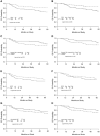Markers of angiogenesis in high-risk, early-stage cervical cancer: A Gynecologic Oncology Group study
- PMID: 19110305
- PMCID: PMC2858218
- DOI: 10.1016/j.ygyno.2008.11.013
Markers of angiogenesis in high-risk, early-stage cervical cancer: A Gynecologic Oncology Group study
Abstract
Objectives: To determine whether markers of tumor angiogenesis were associated with progression-free survival (PFS) and overall survival (OS) in women with high-risk, early-stage cervical cancer treated on a phase III trial.
Methods: One hundred seventy-three tumor specimens were analyzed by semi-quantitative immunohistochemical (IHC) staining for vascular endothelial growth factor (VEGF, pro-angiogenesis factor), thrombospondin-1 (TSP-1, anti-angiogenesis factor), CD31 (non-specific endothelial marker), and CD105 (tumor-specific endothelial marker). Tumoral histoscores (HS) were calculated for VEGF using the formula: [% cells positivex(intensity+1)]. TSP-1 specimens were categorized as negative or positive. CD31 and CD105 microvessel density (MVD) "hotspots" were counted in three 20x high-power fields. Associations between angiogenesis markers and survival were evaluated.
Results: TSP-1 expression was observed in 65% of cases while 66% expressed high VEGF (>or=200), 34% exhibited high CD31 (CD31>or=110) and 66% displayed high CD105 (CD105>or=28). In univariate analyses CD31 MVD, but not tumor TSP-1, was associated with improved PFS (HR=0.37; 95% CI=0.18-0.76; p=0.007) and OS (HR=0.37; 95% CI=0.17-0.79; p=0.010). After adjusting for prognostic clinical covariates, high CD31 MVD, but not TSP-1, VEGF or CD105 MVD, was an independent prognostic factor for PFS (HR=0.36; 95% CI=0.17-0.75; p=0.006) and OS (HR=0.36; 95% CI=0.17-0.79; p=0.010).
Conclusions: Tumor angiogenesis measured by CD31 MVD is an independent prognostic factor for both PFS and OS in high-risk, early-stage cervical cancer. We hypothesize that this finding may be explained by improved treatment response in well-vascularized, well-oxygenated tumors.
Figures
References
-
- Parkin DM, Bray F, Ferlay J, et al. Global cancer statistics, 2002. CA Cancer J Clin. 2005;55:4–10. - PubMed
-
- Ries LAG, Melbert D, Krapcho M. SEER cancer statistics review, 1975–2004. National Cancer Institute; Bethesda, MD: ( http://seer.cancer.gov/csr/1975_2004/, based on November 2006 SEER data submission, posted to the SEER web site, 2007)
-
- Delgado G, Bundy B, Zaino R, et al. Prospective surgical–pathological study of disease-free interval in patients with stage IB squamous cell carcinoma of the cervix: a Gynecologic Oncology Group study. Gynecol Oncol. 1990;38:352–7. - PubMed
-
- Monk BJ, Wang J, Im S, et al. Rethinking the use of radiation and chemotherapy after radical hysterectomy: a clinical-pathologic analysis of a Gynecologic Oncology Group/Southwest Oncology Group/Radiation Therapy Oncology Group trial. Gynecol Oncol. 2005;96:721–8. - PubMed
-
- Im SS, Wilczynski SP, Burger RA, et al. Early stage cervical cancers containing human papillomavirus type 18 DNA have more nodal metastasis and deeper stromal invasion. Clin Cancer Res. 2003;9:4145–50. - PubMed


